
|
|
|
|
 |
|
Home Site Search Contact Us Subscribe
|
|
|
|
East Meets West on the Waterfront: Esplanade - Theatres on the Bay by Michael Wilford & Partners; DP Architects; Theatre Projects Consultants; and Artec Consultants
Singapore: A performing arts complex 30 years in the making puts a strictly-business city on the international cultural map. by Kristen Richards January 16, 2003 Is there an arts complex
anywhere in the world that hasn’t generated political, economic, cultural, and
aesthetic controversies? The newest is Singapore’s Esplanade - Theatres on the Bay. Nearly 30
years after the idea of a national arts center for Singapore was first
conceived, and 12 years since the Steering Committee that guided its birth was
formed, the Esplanade formally opened on October 12, 2002, (The government even
issued commemorative stamps to
mark the occasion. Since gaining independence in 1965,
Singapore has become an economic dynamo, and a local truism says there are five
“C’s” to happiness: car, cash, condo, credit card, and country club. The Esplanade is the
government’s impressive step to add a sixth “C” – “culture” – to the mix. The complex sits
on six hectares (almost 15 acres) of prime waterfront land on Marina Bay, and
is primed, both architecturally and technically, to put Singapore on the
international cultural map. There was no doubt that the performance venues had to meet the highest
of standards for the Esplanade to attract world-class performers. To that end,
the project was designed from the inside out. In 1990, the London office of
Theatre Projects Consultants (TPC) was among the first on an international
team, writing both the theater and the architectural brief, and assisting in the
selection of architects. Also brought on board early was acoustics specialist
Artec Consultants. The architectural controversy began in 1991 with questions about why
such an important project was not an open international competition.
London-based James Stirling Michael Wilford &
Associates and DP Architects of Singapore won out over three other short-listed
teams from a field of 48 architects invited to pre-qualify for the design stage
of the competition. Stirling died in June 1992. The re-named Michael Wilford
& Partners (MWP) and DP Architects (DPA) designed the competition entry,
and were named the winning team in December 1992. The final design was
completed in 1995, at the same time the Ministry of Information and the Arts
decided to make it a two-phase project. At that point, for logistical and/or
political exigencies (depending on which official or rumoured reports one
reads), MWP handed the reins to DPA to complete the first phase. The original plans
called for five major performance spaces. The SGD$600-million first phase includes the 2,000-seat
Lyric Theatre and the 1,800-seat Concert Hall, in addition to a 250-seat
recital studio, and 220-seat theater studio, plus outdoor performance spaces,
private functions rooms, dining, and (of course) a shopping mall. Singapore is only about 83 miles from the equator, and has a tropical
rain-forest climate with uniformly high temperatures and rainfall throughout
the year. “We always try to make foyers a place of social intercourse,” says
architect Michael Wilford. “We wanted the public areas of Esplanade to be open
and visible to the outside world during the day, while at night giving people a
stunning view over the city. This meant a lot of glass, which is not
necessarily compatible with a tropical climate! The challenge was to design an
essentially glazed building yet protect it from the sun and heat.” Because the sun’s position and movement is constant year round, the
architects devised a fixed cladding system consisting of a glazed steel space
frame with triangular aluminum sun shields. The shields are set to be more open
or closed, depending on the angle the sun hits them, so the glass facades are
protected from direct sunlight without limiting the views. This textured
sunshade skin has given rise to a number of endearing (and not-so-endearing)
nicknames for the complex, such as “petals,” “fish scales,” and “bug’s eyes.”
Singaporeans (also known as “heartlanders”) have seemed to settle on calling it
“the durian” – a sweet local fruit known for its prickly skin and noxious smell.
Surrounded by the high-rise buildings of Singapore city, including the
70-story Swissôtel (The Stamford), Esplanade is also designed to be viewed from
above. “For example, the fly tower of a theater is usually hidden from view,
surrounded by buildings. In Esplanade, it had to be an integral part of the
design”, explained Wilford. There is also no “back door.” The location, on
Marina Bay between the historic/civic districts and the modern city, gives the
building three main public edges. Wilford describes it as a building with
“three fronts and no backs.” The typical back doors of a theater, such as the
loading dock, are part of one of the frontages. From the outset, TPC worked closely with Singapore’s performing arts
organizations to ensure that the Esplanade would accommodate the full range of
performing arts, both Eastern and Western, as well as the most advanced
multimedia presentations. “Singapore is a pretty unique country,” says David
Staples, managing director of TPC’s London office. “It is small and
multicultural, and has four official languages – Mandarin, Malay, Tamil, and
English. It also, incidentally, has one of the highest literacy rates in the
world.” Staples and his team spent considerable time studying and understanding
the needs of the eastern arts, such as Chinese opera, Indian music and dance,
and Indonesian and Malay performance. While the venues are still pretty much
Western in design, there are characteristics peculiar to Asia. The greatest
difference between the two is that the East has no tradition of indoor theater.
“Eastern performance art almost always takes place outside,” Staples explains.
“The opening festival featured some 600 free outdoor performances.” Two main
outdoor venues were incorporated into the design. The Outdoor Theatre, which
sits on the 300-meter-long waterfront along Marina Bay, and The Edge, most
suited for medium to large-scale performances. There is also plenty of
opportunity for people to meet, eat, drink and be entertained outdoors,
including the open air Courtyard at Esplanade Mall. Internal venues also had to reflect Asian performance. Asian music is
also different – louder and more percussive. TPC and Artec Consultants
developed three main devices in the Concert Hall to create some of the most
flexible acoustics in the world. The hall is connected to huge reverberation
chambers by 58 concrete doors that can be partially or fully opened in
different configurations. These, together with 1,000 square meters of acoustic
banners, allow the hall to be fine tuned, even from one piece of music to the next.
Finally, over the concert platform are three acoustic canopies that can be
raised or lowered as required, and which are especially important in helping
musicians on stage hear each other. The acoustic chambers give the Concert Hall
the form of a box-within-a-box (the reverberation chambers actually double the
volume of the hall). The Lyric Theatre has the horseshoe shape of classic European opera
houses with four galleries and the largest performing stage in Singapore. This
accommodates Chinese opera and Indian dance, for example, where the musicians
are on stage with the performers, unlike western culture, where the orchestra
is hidden in a pit. The theater’s proscenium width, adjustable from 14 to 16.5
meters, is a good two meters wider than is usual in the west. Flexible
acoustics were important here as well. For speech and amplified music events, a
series of acoustic banners can be lowered into the room to reduce the
reverberation time. Both theaters sit on rubber footings to isolate them from
the vibrations of nearby subway lines. Having overseen the commissioning of the equipment and arranged the
handover to the client, Theatre Projects Consultants will continue to monitor
both the project and the equipment for the next two years. The Esplanade has
already won the bid to host the 17th Congress for the International
Society for the Performing Arts in June 2003, the first time the Congress has
been held in Asia – and the first time the Society has chosen a center prior to
its opening. The complex also includes the 2,300-square-meter library@esplanade, the
country’s first “themed” library devoted to music, dance, theater, and film.
The Esplanade’s mission statement says: “To
entertain, engage, educate and inspire.” A two-day open house prior to the official
opening attracted a reported 400,000 heartlanders – that’s about 10 percent of
the entire population. Then followed a three-week
opening festival that included 1,300 artists
from 22 countries, performing in 70 different productions. Certainly the grand
opening and the current calendar of international performerances bode
auspicious beginnings. Client: Public Works Department and
Singapore Arts Centre Company Ltd. Theatre Planners/Consultants: Theatre Project
Consultants (UK) Acoustic Consultant: Artec Consultants Inc (USA) Project Manager/MEP/Cost Consultant: PWD
Consultants Pte Ltd (Singapore) Main Contractor: Penta-Ocean Construction Co Ltd
(Japan) Cladding Contractor: Mero Raumstruktur Gmbh
& Co (Germany) Cladding Consultant: Atelier Group Of Companies
(Germany) Pipe Organ: Orgelbau Klais Bonn (Germany) Landscape Designer: Aspinwall Clouston (Hong
Kong) Lighting Consultant (Architectural): Vision
Design Studio (Australia) Signage Consultant: Word Naker Design
(Singapore) Basement Carpark Contractor: Sato Kogyo Co Ltd
(Japan) In 1960, Michael Wilford joined the practice that James Stirling
created in 1956. The Stirling/Wilford partnership was established in 1971 and
continued until James Stirling's death in 1992. From 1993 to 2001 Michael
Wilford worked in partnership under the name of Michael Wilford and Partners.
In London, Michael Wilford is now working in collaboration with MUMA (McInnes, Usher, McKnight Architects), and in Germany has
established Wilford Schupp, based in Stuttgart. DP Architects was incorporated in 1975 as a
continuation of Design Partnership founded in 1967. In the last 30 years, the
firm has established significant presence in Singapore with offices in
Malaysia, Philippines, Hong Kong, Indonesia, and China. It is an award-winning
firm offering a wide range of services from architecture and urban
design/planning, to interior design, graphic design, and project management. In
1982, two subsidiary companies, DP Design and DP Consultants, were established.
Clients include public and private companies, government and semi-government
bodies, institutions, and private developers. Theatre Projects Consultants (TPC) was founded by Richard
Pilbrow in 1957, and has offices in South Norwalk, Conn., London, Los Angeles,
Toronto, and Singapore. Recent projects include the Kodak Theatre, Hollywood;
Kimmel Center, Philadelphia; New Amsterdam Theatre renovation, New York City;
New Goodman Theatre, Chicago; the Glyndebourne Opera House, Sussex, England;
renovation work for the Kennedy Center, Washington, D.C.; performing arts
centers in Dayton, Ohio; Madison, Wisconsin; Tempe, Arizona; and Dallas; the
Esplanade Cultural Center, Singapore; the Walt Disney Concert Hall, Los
Angeles; and new opera houses in Galicia, Spain, and Oslo, Norway. Artec Consultants
Inc. was
founded in 1970 by Russell Johnson. Some of the New York City-based firm’s most
prestigious accomplishments include: Symphony Hall, Birmingham, UK; the
Meyerson Symphony Center, Dallas; the Culture and Congress Centre, Lucerne,
Switzerland; Sala Sao Paulo, Sao Paulo, Brazil; l’Auditorium, Dijon, France;
and the Chan Centre for the Performing Arts, Vancouver, B. C. Facilities
currently in design include an opera house and concert hall in Singapore; the
renovation of the Roy Thomson Hall, Toronto; a concert hall in Costa Mesa,
Calif.; and an opera house and concert hall in Miami. PWD Corporation and its subsidiary, PWD Consultants, was established in 1999 when the former
Singapore Public Works Department was re-formed as a corporation. In July
2002, the firm changed its name to CPG Corporation Pte Ltd (signifying “creative professionals group”). Based in
Singapore, it is one of Asia’s leading development and management firms with a
staff of 2,000 in offices in People’s Republic of China, India, the
Philippines, and the Middle East. Building and infrastructure development
services include master planning, architectural and engineering design and
consultancy, project management, design/build, facilities management, and
diagnostic and quality assurance testing. |
(click on pictures to enlarge) 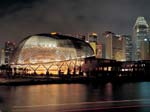 (Eujin Goh) The Esplanade - Theatres on the Bay glows against the Singapore skyline.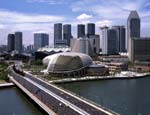 (Hidetaka Mori for DP Architects) View from across the bay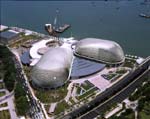 (Hidetaka Mori for DP Architects) Bird's-eye view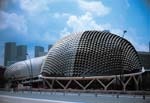 (Eujin Goh) The complex from Esplanade Drive (Eujin Goh) View from Esplanade Park (Hidetaka Mori for DP Architects) Detail of aluminum sunshade skin, akin to the prickly durian fruit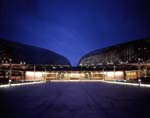 (Hidetaka Mori for DP Architects) The main entrance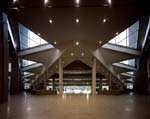 (Hidetaka Mori for DP Architects) The grand concourse inside the main entrance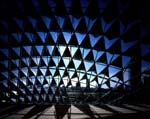 (Hidetaka Mori for DP Architects) View from the inside out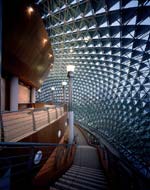 (Hidetaka Mori for DP Architects) During the day, multi-level lobbies and foyers are flooded with natural light.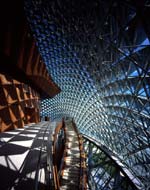 (Hidetaka Mori for DP Architects) Another foyer view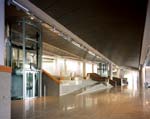 (Hidetaka Mori for DP Architects) The grand lobby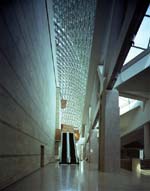 (Hidetaka Mori for DP Architects) Natural light streams down to the lower level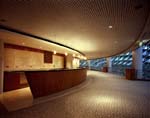 (Hidetaka Mori for DP Architects) An intermission refreshment bar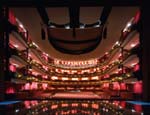 (Hidetaka Mori for DP Architects) The 2,000-seat Lyric Theatre is styled after classic, horseshoe-shaped European opera houses.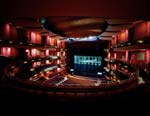 (Hidetaka Mori for DP Architects) The theater's flexible stage and acoustic ceiling banners allows for a multitude of performance arts.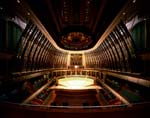 (Hidetaka Mori for DP Architects) The focal point of the 1,800-seat Concert Hall is a magnificent Klais organ.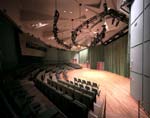 (Hidetaka Mori for DP Architects) The 250-seat Recital Studio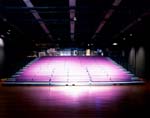 (Hidetaka Mori for DP Architects) The 220-seat Theatre Studio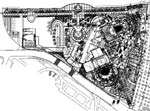 (-) Site plan |
© 2003 ArchNewsNow.com